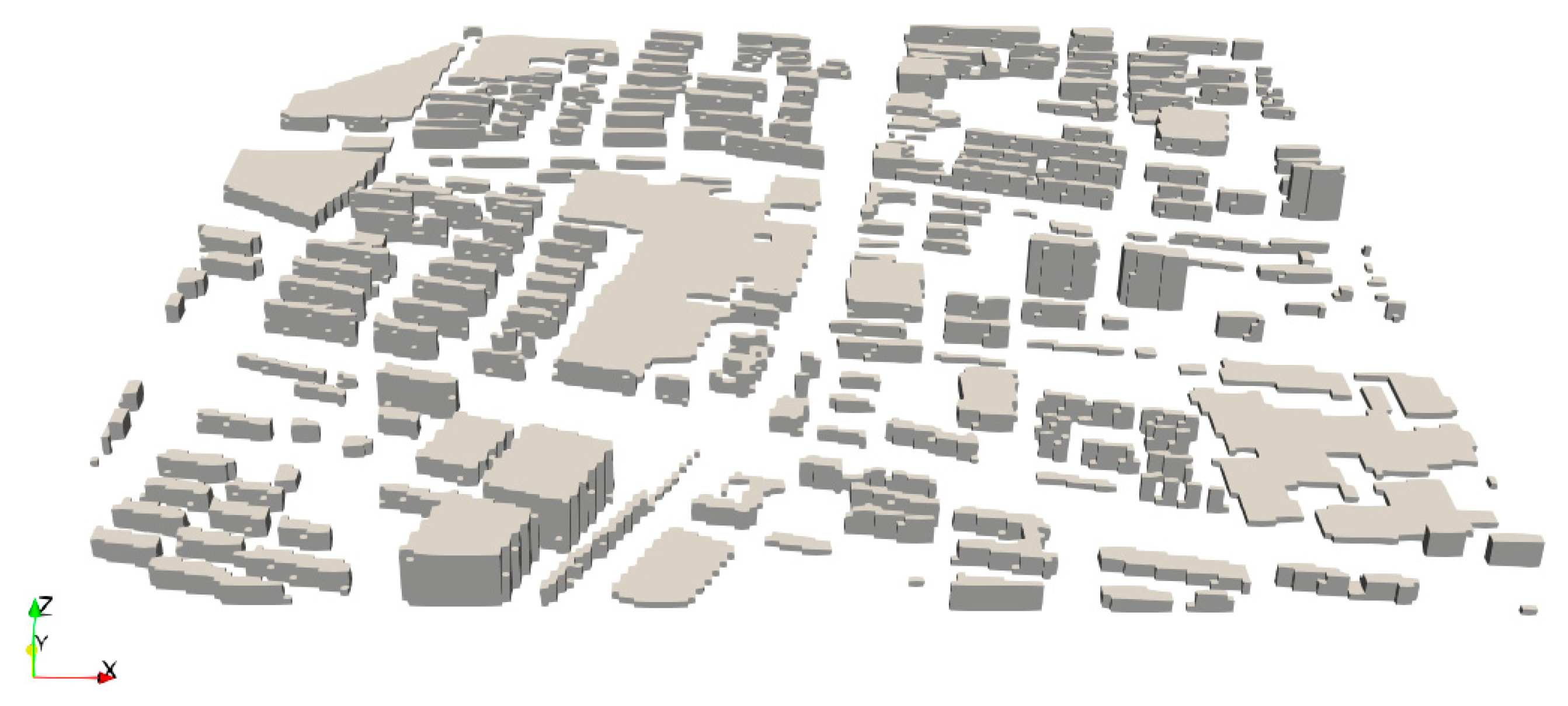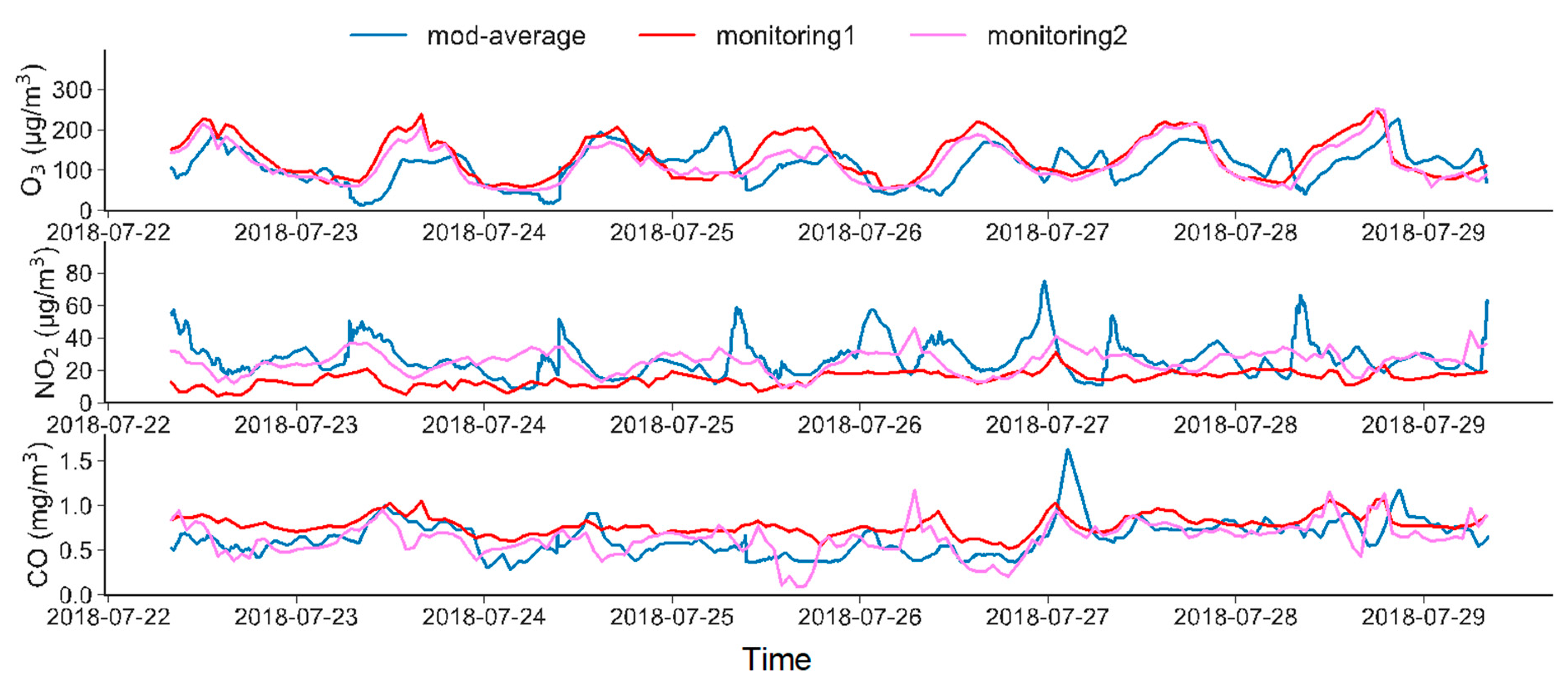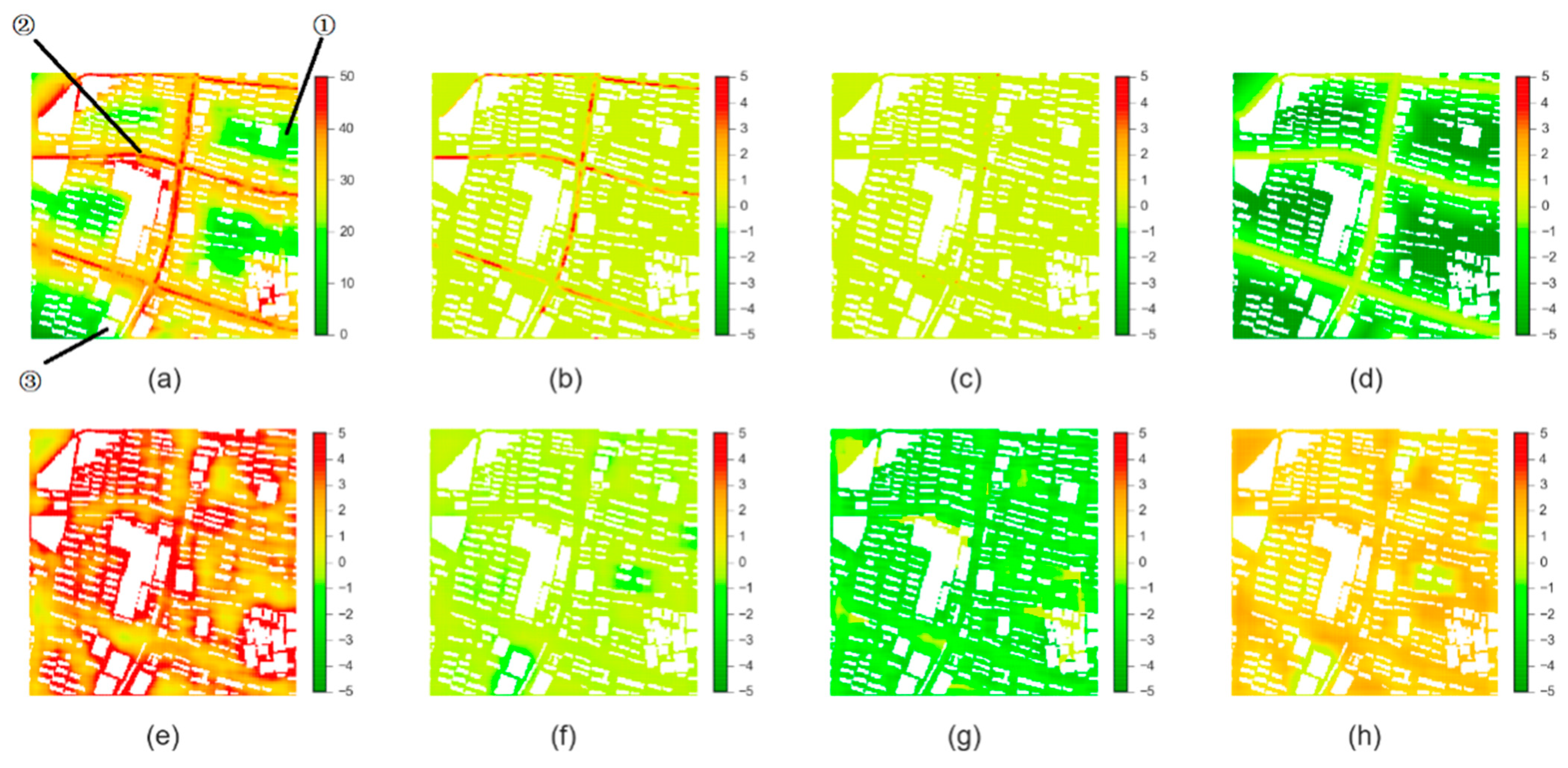Evaluation of the Street Canyon Level Air Pollution Distribution Pattern in a Typical City Block in Baoding, China
Abstract
:1. Introduction
2. Method
2.1. Model Description
2.2. Model Configuration and Evaluation
Study Area and Time
2.3. Model Configuration and Initialization
2.4. Model Evaluation
2.5. Data Analysis
Parameters Describing the Urban Form
2.6. Multi-Linear Regression
3. Results and Discussion
3.1. Effects of Urban Morphological Factors on Dispersion of Traffic Pollutants
3.2. Urban Morphology Pollution Index (UMPI)
4. Conclusions
Supplementary Materials
Author Contributions
Funding
Data Availability Statement
Conflicts of Interest
References
- Maji, K.J.; Dikshit, A.K.; Arora, M.; Deshpande, A. Estimating premature mortality attributable to PM2.5 exposure and benefit of air pollution control policies in China for 2020. Sci. Total Environ. 2018, 612, 683–693. [Google Scholar] [CrossRef] [PubMed]
- Maji, K.J.; Ye, W.-F.; Arora, M.; Nagendra, S.S. Ozone pollution in Chinese cities: Assessment of seasonal variation, health effects and economic burden. Environ. Pollut. 2019, 247, 792–801. [Google Scholar] [CrossRef] [PubMed]
- Akhter, M.N.; Ali, E.; Rahman, M.M.; Hossain, N.; Molla, M. Simulation of air pollution dispersion in Dhaka city street canyon. AIP Adv. 2021, 11, 065022. [Google Scholar] [CrossRef]
- Fu, X.; Liu, J.; Ban-Weiss, G.A.; Zhang, J.; Huang, X.; Ouyang, B.; Popoola, O.; Tao, S. Effects of canyon geometry on the distribution of traffic-related air pollution in a large urban area: Implications of a multi-canyon air pollution dispersion model. Atmos. Environ. 2017, 165, 111–121. [Google Scholar] [CrossRef]
- Edussuriya, P.; Chan, A.; Malvin, A. Urban morphology and air quality in dense residential environments: Correlations between morphological parameters and air pollution at street-level. J. Eng. Sci. Technol. 2014, 91, 64–80. [Google Scholar]
- Yang, J.; Shi, B.; Zheng, Y.; Shi, Y.; Xia, G. Urban form and air pollution disperse: Key indexes and mitigation strategies. Sustain. Cities Soc. 2019, 57, 101955. [Google Scholar] [CrossRef]
- Idrissi, M.S.; Lakhal, F.A.; Salah, N.B.; Chrigui, M. CFD modeling of air pollution dispersion in complex urban area. In Proceedings of the International Conference Design and Modeling of Mechanical Systems, Hammamet, Tunisia, 27–29 March 2017. [Google Scholar]
- Jurado, X.; Reiminger, N.; Vazquez, J.; Wemmert, C. On the minimal wind directions required to assess mean annual air pollution concentration based on CFD results. Sustain. Cities Soc. 2021, 71, 102920. [Google Scholar] [CrossRef]
- Raasch, S.; Schröter, M. PALM-A large-eddy simulation model performing on massively parallel computers. Meteorol. Z. 2001, 10, 363–372. [Google Scholar] [CrossRef]
- Raasch, S.; Harbusch, G. An Analysis Of Secondary Circulations And Their Effects Caused By Small-Scale Surface Inhomogeneities Using Large-Eddy Simulation. Bound. Layer Meteorol. 2001, 101, 31–59. [Google Scholar] [CrossRef]
- Letzel, M.O.; Raasch, S. Large Eddy Simulation of Thermally Induced Oscillations in the Convective Boundary Layer. J. Atmos. Sci. 2003, 60, 2328–2341. [Google Scholar] [CrossRef]
- Park, S.-B.; Baik, J.-J.; Raasch, S.; Letzel, M.O. A Large-Eddy Simulation Study of Thermal Effects on Turbulent Flow and Dispersion in and above a Street Canyon. J. Appl. Meteorol. Climatol. 2011, 51, 829–841. [Google Scholar] [CrossRef]
- Kanda, M.; Inagaki, A.; Miyamoto, T.; Gryschka, M.; Raasch, S. A New Aerodynamic Parametrization for Real Urban Surfaces. Bound. Layer Meteorol. 2013, 148, 357–377. [Google Scholar] [CrossRef]
- Riechelmann, T.; Wacker, U.; Beheng, K.D.; Etling, D.; Raasch, S. Influence of turbulence on the drop growth in warm clouds, PartII: Sensitivity studies with a spectral bin microphysics and a Lagrangian cloud model. Meteorol. Z. 2015, 24, 293–311. [Google Scholar] [CrossRef]
- Hoffmann, F.; Raasch, S.; Noh, Y. Entrainment of aerosols and their activation in a shallow cumulus cloud studied with a coupled LCM–LES approach. Atmos. Res. 2015, 156, 43–57. [Google Scholar] [CrossRef]
- Beare, R.J.; Macvean, M.K.; Holtslag, B.; Cuxart, J.; Esau, I.; Golaz, J.-C.; Jiménez, M.A.; Khairoutdinov, M.; Kosovic, B.; Lewellen, D.; et al. An Intercomparison of Large-Eddy Simulations of the Stable Boundary Layer. Bound. Layer Meteorol. 2006, 118, 247–272. [Google Scholar] [CrossRef]
- Wicker, L.J.; Skamarock, W.C. Time-Splitting Methods for Elastic Models Using Forward Time Schemes. Mon. Weather. Rev. 2002, 130, 2088–2097. [Google Scholar] [CrossRef]
- Arakawa, A.; Lamb, V.R. Lamb, Computational design of the basic dynamical processes of the UCLA general circulation model. Gen. Circ. Models Atmos. 1977, 17, 173–265. [Google Scholar]
- Cavaglieri, D.; Bewley, T. Low-storage implicit/explicit Runge-Kutta schemes for the simulation of stiff high-dimensional ODE systems. J. Comput. Phys. 2015, 286, 172–193. [Google Scholar] [CrossRef]
- Diehl, R.; Busch, K.; Niegemann, J. Comparison of Low-Storage Runge-Kutta Schemes for Discontinuous Galerkin Time-Domain Simulations of Maxwell’s Equations. J. Comput. Theor. Nanosci. 2010, 7, 1572–1580. [Google Scholar] [CrossRef]
- Kennedy, C.A.; Carpenter, M.H.; Lewis, R.M. Low-storage, explicit Runge-Kutta schemes for the compressible Navier-Stokes equations. Appl. Numer. Math. 2000, 35, 177–219. [Google Scholar] [CrossRef]
- Williamson, J.H. Low-storage Runge-Kutta schemes. J. Comput. Phys. 1980, 35, 48–56. [Google Scholar] [CrossRef]
- Maronga, B.; Gryschka, M.; Heinze, R.; Hoffmann, F.; Kanani-Sühring, F.; Keck, M.; Ketelsen, K.; Letzel, M.O.; Sühring, M.; Raasch, S. The Parallelized Large-Eddy Simulation Model (PALM) version 4.0 for atmospheric and oceanic flows: Model formulation, recent developments, and future perspectives. Geosci. Model Dev. 2015, 8, 2515–2551. [Google Scholar] [CrossRef]
- Ji, X.; Liu, C.; Xie, Z.; Hu, Q.; Dong, Y.; Fan, G.; Zhang, T.; Xing, C.; Wang, Z.; Javed, Z.; et al. Comparison of mixing layer height inversion algorithms using lidar and a pollution case study in Baoding, China. J. Environ. Sci. 2019, 79, 81–90. [Google Scholar] [CrossRef] [PubMed]
- Jiang, L.; Bai, L. Spatio-temporal characteristics of urban air pollutions and their causal relationships: Evidence from Beijing and its neighboring cities. Sci. Rep. 2018, 8, 1279. [Google Scholar] [CrossRef]
- Fu, X.; Xiang, S.; Liu, Y.; Liu, J.; Yu, J.; Mauzerall, D.L.; Tao, S. High-resolution simulation of local traffic-related NOx dispersion and distribution in a complex urban terrain. Environ. Pollut. 2020, 263, 114390. [Google Scholar] [CrossRef] [PubMed]
- Gerling, L.; Wiedensohler, A.; Weber, S. Statistical modelling of spatial and temporal variation in urban particle number size distribution at traffic and background sites. Atmos. Environ. 2021, 244, 117925. [Google Scholar] [CrossRef]
- Harrison, R.M.; Van Vu, T.; Jafar, H.; Shi, Z. More mileage in reducing urban air pollution from road traffic. Environ. Int. 2021, 149, 106329. [Google Scholar] [CrossRef]
- Schiavon, M.; Redivo, M.; Antonacci, G.; Rada, E.C.; Ragazzi, M.; Zardi, D.; Giovannini, L. Assessing the air quality impact of nitrogen oxides and benzene from road traffic and domestic heating and the associated cancer risk in an urban area of Verona (Italy). Atmos. Environ. 2015, 120, 234–243. [Google Scholar] [CrossRef]
- Badol, C.; Locoge, N.; Galloo, J.-C. Using a source-receptor approach to characterise VOC behaviour in a French urban area influenced by industrial emissions: Part II: Source contribution assessment using the Chemical Mass Balance (CMB) model. Sci. Total Environ. 2008, 389, 429–440. [Google Scholar] [CrossRef]
- Hao, J.; Wu, Y.; Fu, L.; He, D.; He, K. Source contributions to ambient concentrations of CO and NOX in the urban area of Beijing. J. Environ. Sci. Health 2001, 36, 215–228. [Google Scholar] [CrossRef]
- Chen, G.-L.; Zhou, Y.; Cheng, S.-Y.; Yang, X.-W.; Wang, X.-Q. Air Pollutant Emission Inventory and Impact of Typical Industries on PM2.5 in Chengde. Environ. Sci. 2016, 37, 4069–4079. (In Chinese) [Google Scholar]
- Bonczak, B.; Kontokosta, C.E. Large-scale parameterization of 3D building morphology in complex urban landscapes using aerial LiDAR and city administrative data. Comput. Environ. Urban Syst. 2019, 73, 126–142. [Google Scholar] [CrossRef]
- Adolphe, L.J.E. A simplified model of urban morphology: Application to an analysis of the environmental performance of cities. Environ. Plan. B Plan. Des. 2001, 28, 183–200. [Google Scholar] [CrossRef]
- Li, Z.; Zhang, H.; Wen, C.-Y.; Yang, A.-S.; Juan, Y.-H. Effects of height-asymmetric street canyon configurations on outdoor air temperature and air quality. Build. Environ. 2020, 183, 107195. [Google Scholar] [CrossRef]
- Gál, T.; Unger, J. Detection of ventilation paths using high-resolution roughness parameter mapping in a large urban area. Build. Environ. 2009, 44, 198–206. [Google Scholar] [CrossRef]
- Vittinghoff, E.; Gliddon, D.V.; Shiboski, S.C.; McCulloch, C.E. Regression Methods in Biostatistics; Springer: New York, NY, USA, 2005. [Google Scholar]




| Parameter | Definition | Equation |
|---|---|---|
| BCR | Density of the building groups | |
| Rugosity | Average height of the urban canopy | |
| Porosity | Open area of pores | |
| Occlusivity | Openness of the urban spaces | |
| Asymmetry ratio (H1/H2) | Asymmetry of the street canyon | |
| Aspect ratio (H/W) | Depth of the street canyon | |
| Distance from the main road (DR) | Shortest distance from the main road |
| Pollutant | NO2 (µg·m−3) | O3 (µg·m−3) | CO (mg·m−3) |
|---|---|---|---|
| R2 | 0.71 | 0.47 | 0.77 |
| Emission a,b | 0.56 * | −0.42 * | 0.64 * |
| DR (m) | −0.28 * | 0.25 * | −0.12 * |
| Aspect ratio (H/W) | 0.06 * | 0.02 * | 0.06 * |
| Asymmetry (H1/H2) | 0.13 * | −0.12 * | 0.24 * |
| BCR | 0.13 * | 0.25 * | 0.18 * |
| Rugosity | −0.03 | 0.03 | −0.01 |
| Occlusivity | −0.05 * | −0.03 * | −0.06 * |
| Porosity | 0.05 * | 0.03 | 0.05 * |
| Pollutant | NO2 (µg/m3) | O3 (µg/m3) | CO (mg/m3) |
|---|---|---|---|
| R2 | 0.53 | 0.35 | 0.53 |
| DR (m) a | −0.52 * | 0.45 * | −0.41 * |
| Aspect ratio (H/W) | 0.03 * | 0.06 * | 0.03 * |
| Asymmetry (H1/H2) | 0.31 * | −0.27 * | 0.44 * |
| BCR | 0.06 * | −0.10 * | 0.01 |
| Rugosity | 0.00 | 0.03 | 0.02 |
| Occlusivity | −0.05 * | 0.07 * | −0.03 * |
| Porosity | 0.11 * | −0.11 * | 0.09 * |
| Pollutant | NO2 | O3 | CO | |||
|---|---|---|---|---|---|---|
| Road | Non-Road | Road | Non-Road | Road | Non-Road | |
| Emission | 0.46 ** | / | −0.48 ** | / | 0.57 ** | / |
| DR | / | −0.15 ** | / | 0.22 ** | / | −0.07 ** |
| Aspect ratio (H/W) | 0.24 ** | / | −0.16 ** | / | 0.36 ** | / |
| Asymmetry (H1/H2) | 0.16 ** | / | −0.13 ** | / | 0.23 ** | / |
| BCR | 0.01 | 0.04 ** | 0.05 ** | −0.04 ** | 0.02 | 0.01 ** |
| Rugosity | −0.27 ** | −0.03 ** | 0.73 ** | 0.02 ** | −0.15 ** | −0.02 ** |
| Occlusivity | −0.03 ** | 0.03 ** | 0.07 ** | −0.03 ** | −0.03 * | 0.02 ** |
| Porosity | 0.09 ** | 0.01 ** | −0.25 ** | 0.00 | 0.05 ** | 0.01 ** |
| NO2 | O3 | CO | |
|---|---|---|---|
| r | 0.70 | 0.56 | 0.71 |
| k | 0.010 | −0.008 | 0.010 |
Publisher’s Note: MDPI stays neutral with regard to jurisdictional claims in published maps and institutional affiliations. |
© 2022 by the authors. Licensee MDPI, Basel, Switzerland. This article is an open access article distributed under the terms and conditions of the Creative Commons Attribution (CC BY) license (https://creativecommons.org/licenses/by/4.0/).
Share and Cite
Zhou, J.; Liu, J.; Xiang, S.; Zhang, Y.; Wang, Y.; Ge, W.; Hu, J.; Wan, Y.; Wang, X.; Liu, Y.; et al. Evaluation of the Street Canyon Level Air Pollution Distribution Pattern in a Typical City Block in Baoding, China. Int. J. Environ. Res. Public Health 2022, 19, 10432. https://doi.org/10.3390/ijerph191610432
Zhou J, Liu J, Xiang S, Zhang Y, Wang Y, Ge W, Hu J, Wan Y, Wang X, Liu Y, et al. Evaluation of the Street Canyon Level Air Pollution Distribution Pattern in a Typical City Block in Baoding, China. International Journal of Environmental Research and Public Health. 2022; 19(16):10432. https://doi.org/10.3390/ijerph191610432
Chicago/Turabian StyleZhou, Jingcheng, Junfeng Liu, Songlin Xiang, Yizhou Zhang, Yuqing Wang, Wendong Ge, Jianying Hu, Yi Wan, Xuejun Wang, Ying Liu, and et al. 2022. "Evaluation of the Street Canyon Level Air Pollution Distribution Pattern in a Typical City Block in Baoding, China" International Journal of Environmental Research and Public Health 19, no. 16: 10432. https://doi.org/10.3390/ijerph191610432






